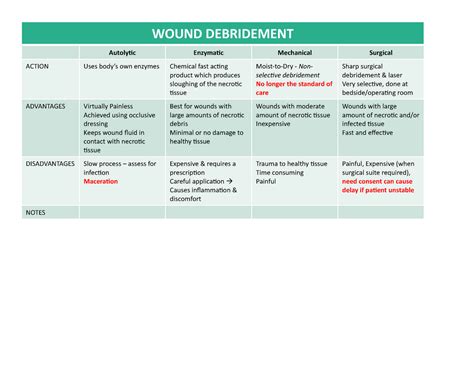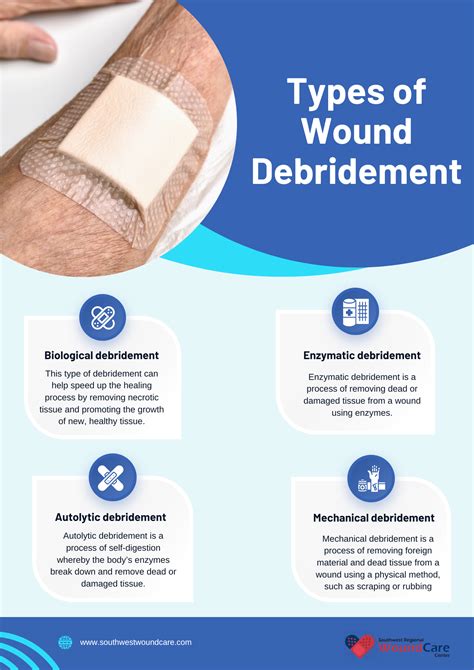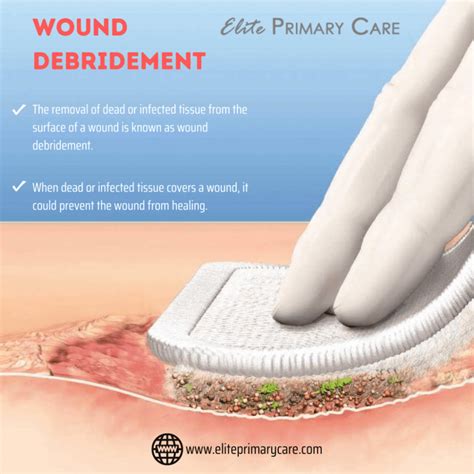Intro
Learn about Wound Debridement Procedure, a medical treatment using surgical, autolytic, or mechanical methods to remove dead tissue, promoting wound healing, tissue repair, and infection control, with techniques like sharp debridement and enzymatic debridement.
The process of wound debridement is a crucial aspect of wound care, as it enables healthcare professionals to effectively manage and treat various types of wounds. Wound debridement is a procedure that involves the removal of dead, damaged, or infected tissue from a wound to promote healing and prevent further complications. This procedure is essential for wounds that are not healing properly, as it helps to create an environment that is conducive to the healing process. In this article, we will delve into the world of wound debridement, exploring its importance, benefits, and the various methods used to perform this procedure.
The importance of wound debridement cannot be overstated, as it plays a critical role in the wound healing process. When a wound is left to heal on its own, it can become trapped in a state of chronic inflammation, which can lead to further complications and delayed healing. By removing dead and damaged tissue, wound debridement helps to reduce the risk of infection, promote granulation tissue formation, and enhance the overall healing process. Furthermore, wound debridement can also help to reduce the risk of amputation, which is a common complication associated with chronic wounds.
Wound debridement is a complex procedure that requires a thorough understanding of wound care principles and the various methods used to perform this procedure. There are several methods of wound debridement, including surgical, autolytic, enzymatic, and mechanical debridement. Each method has its own advantages and disadvantages, and the choice of method depends on the type and severity of the wound, as well as the patient's overall health status. In the following sections, we will explore each of these methods in detail, highlighting their benefits and drawbacks, and discussing the various factors that influence the choice of method.
Introduction to Wound Debridement

Benefits of Wound Debridement
The benefits of wound debridement are numerous, and this procedure plays a critical role in the wound healing process. Some of the benefits of wound debridement include: * Promoting wound healing by removing dead and damaged tissue * Reducing the risk of infection by removing bacteria and other microorganisms * Enhancing the formation of granulation tissue, which is essential for wound healing * Reducing the risk of amputation, which is a common complication associated with chronic wounds * Improving the overall quality of life for patients with chronic woundsMethods of Wound Debridement

Surgical Debridement
Surgical debridement is a method of wound debridement that involves the use of surgical instruments to remove dead and damaged tissue. This method is typically used for wounds that are large or deep, and is often performed in an operating room. Surgical debridement is a highly effective method of wound debridement, but it can be painful and may require anesthesia.Autolytic Debridement
Autolytic debridement is a method of wound debridement that involves the use of dressings to promote the breakdown and removal of dead tissue. This method is typically used for wounds that are small or superficial, and is often performed in a clinical setting. Autolytic debridement is a slow and gentle method of wound debridement, but it can be effective for promoting wound healing.Enzymatic Debridement
Enzymatic debridement is a method of wound debridement that involves the use of enzymes to break down and remove dead tissue. This method is typically used for wounds that are large or deep, and is often performed in a clinical setting. Enzymatic debridement is a highly effective method of wound debridement, but it can be expensive and may require specialized equipment.Mechanical Debridement
Mechanical debridement is a method of wound debridement that involves the use of physical forces to remove dead and damaged tissue. This method is typically used for wounds that are small or superficial, and is often performed in a clinical setting. Mechanical debridement is a fast and effective method of wound debridement, but it can be painful and may require anesthesia.Steps Involved in Wound Debridement

Preparation of the Wound and Surrounding Area
Preparation of the wound and surrounding area is an essential step in wound debridement. This involves cleaning the wound and surrounding area with soap and water, and removing any debris or dead tissue. The wound and surrounding area should also be dried thoroughly to prevent bacterial growth.Removal of Dead and Damaged Tissue
Removal of dead and damaged tissue is the primary goal of wound debridement. This can be achieved using various methods, including surgical, autolytic, enzymatic, and mechanical debridement. The choice of method depends on the type and severity of the wound, as well as the patient's overall health status.Cleaning and Dressing of the Wound
Cleaning and dressing of the wound is an essential step in wound debridement. This involves cleaning the wound with soap and water, and applying a dressing to promote wound healing. The dressing should be changed regularly to prevent bacterial growth and promote wound healing.Benefits and Drawbacks of Wound Debridement

However, wound debridement also has some drawbacks, including:
- Pain and discomfort associated with the procedure
- Risk of infection or other complications
- Need for repeated procedures to achieve desired results
- High cost associated with some methods of wound debridement
Conclusion and Future Directions
In conclusion, wound debridement is a highly effective procedure for promoting wound healing. The various methods of wound debridement, including surgical, autolytic, enzymatic, and mechanical debridement, each have their own advantages and disadvantages. The choice of method depends on the type and severity of the wound, as well as the patient's overall health status. As research continues to advance, we can expect to see new and innovative methods of wound debridement emerge, which will further improve our ability to promote wound healing and improve patient outcomes.What is wound debridement?
+Wound debridement is a medical procedure that involves the removal of dead, damaged, or infected tissue from a wound to promote healing and prevent further complications.
What are the benefits of wound debridement?
+The benefits of wound debridement include promoting wound healing, reducing the risk of infection, enhancing the formation of granulation tissue, and reducing the risk of amputation.
What are the different methods of wound debridement?
+The different methods of wound debridement include surgical, autolytic, enzymatic, and mechanical debridement. Each method has its own advantages and disadvantages, and the choice of method depends on the type and severity of the wound, as well as the patient's overall health status.
We hope this article has provided you with a comprehensive understanding of wound debridement and its importance in promoting wound healing. If you have any questions or comments, please do not hesitate to reach out to us. We would be happy to hear from you and provide any additional information or clarification you may need. Additionally, we invite you to share this article with others who may be interested in learning more about wound debridement and its benefits. By working together, we can promote wound healing and improve patient outcomes.
